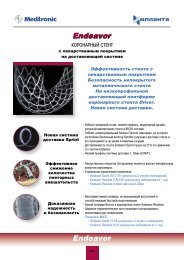Results of Coronary Stenting using the Stents with
Results of Coronary Stenting using the Stents with
Results of Coronary Stenting using the Stents with
You also want an ePaper? Increase the reach of your titles
YUMPU automatically turns print PDFs into web optimized ePapers that Google loves.
Interventional angiology<br />
Table.<br />
Distribution <strong>of</strong> atypical variants <strong>of</strong> <strong>the</strong> PA branching and <strong>of</strong> <strong>the</strong> foot blood supply in 248 cases <strong>of</strong><br />
CLLI when PAP has been performed<br />
TYPE<br />
Cases in total<br />
n (%)<br />
Evident before<br />
PAP<br />
n<br />
Recognized during<br />
PAP<br />
n<br />
Complications<br />
n<br />
Type I<br />
I-B 3 (1,2%) 2 1 0<br />
I-C 5 (2%) 3 2 1<br />
Type II<br />
II-A 2 (0,8%) 1 1 0<br />
II-B 4 (1,6%) 2 2 1<br />
Type III<br />
III-A 8 (2,85%) 3 5 2<br />
III-B 7 (2,82%) 2 5 2<br />
III-C 2 (0,8%) 1 1 1<br />
Total n (%) 31 (12,5%) 14 (45%) 17 (55%) 7 (23%)<br />
ences during group comparison. P value <strong>of</strong> 0,05<br />
was considered as statistically significant.<br />
<strong>Results</strong><br />
The incidence <strong>of</strong> atypical variants <strong>of</strong> <strong>the</strong> PA<br />
branching and <strong>the</strong> foot blood supply in <strong>the</strong> group <strong>of</strong><br />
study is presented in <strong>the</strong> Table.<br />
Distribution <strong>of</strong> atypical variants <strong>of</strong> <strong>the</strong> PA branching<br />
and <strong>of</strong> <strong>the</strong> foot blood supply in 248 cases <strong>of</strong> CLLI<br />
when PAP has been performed<br />
In total, atypical anatomy was noted in 31 cases<br />
(12,5%). Aplasia/hypoplasia <strong>of</strong> <strong>the</strong> tibial branches<br />
<strong>with</strong> DPA and/or PlA arising from <strong>the</strong> PeA were noted<br />
in 17 (6,8%) cases. Only 14 (45%) cases <strong>of</strong> atypical<br />
anatomy were evident at <strong>the</strong> stage <strong>of</strong> preoperative<br />
selective angiography. In seven (41%) <strong>of</strong> <strong>the</strong> remaining<br />
17 cases (which could not be recognized before<br />
PAP) atypical anatomy has been suspected only after<br />
<strong>the</strong> occurrence <strong>of</strong> specific PAP-related complications.<br />
Atypical variants <strong>of</strong> PA branching were associated<br />
<strong>with</strong> 2 complications related to <strong>the</strong> search <strong>of</strong><br />
<strong>the</strong> ostium <strong>of</strong> <strong>the</strong> posterior tibial artery (PTA) in its<br />
“typical” location (Fig. 2). In 5 cases <strong>with</strong> foot blood<br />
supply from <strong>the</strong> PeA system <strong>the</strong> attempt <strong>of</strong> recanalization<br />
<strong>of</strong> hypoplastic tibial arteries resulted in <strong>the</strong>ir<br />
perforation. Clinical consequences have been noted<br />
in 1 (20%) <strong>of</strong> <strong>the</strong>se cases — <strong>the</strong> perforation <strong>of</strong> <strong>the</strong><br />
anterior TA led to hematoma development in <strong>the</strong> anterior<br />
crural muscular bed, which necessitated surgical<br />
decompression.<br />
In <strong>the</strong> group <strong>with</strong> atypical anatomy technical success<br />
was achieved in 28 out <strong>of</strong> 31 cases (90,3%),<br />
while <strong>the</strong> rate <strong>of</strong> success in <strong>the</strong> group <strong>of</strong> 217 cases<br />
<strong>with</strong>out anatomical variants was 93,5% (203 cases).<br />
The comparison <strong>of</strong> <strong>the</strong>se results <strong>with</strong> <strong>the</strong> use <strong>of</strong> exact<br />
Fisher’s test gave Р=0,8. Here<strong>with</strong> both groups were<br />
similar in age, sex and concomitant pathology. Oneyear<br />
rate <strong>of</strong> leg preservation was 83,7% for <strong>the</strong> cases<br />
<strong>with</strong> atypical and 85,9% — for <strong>the</strong> cases <strong>with</strong> typical<br />
anatomy. The comparison <strong>of</strong> Kaplan-Meier curves<br />
<strong>using</strong> LogRank Test did not reveal significant difference<br />
(Р=0.65).<br />
Discussion<br />
According to <strong>the</strong> data <strong>of</strong> two large angiographic<br />
studies, atypical variants <strong>of</strong> PA branching and foot<br />
blood supply were seen in 7,4% and 17,6% <strong>of</strong> cases<br />
(3, 4). Our results (12,5%) are <strong>with</strong>in <strong>the</strong>se limits.<br />
In our opinion, <strong>the</strong> problem <strong>of</strong> specific complications<br />
caused by atypical anatomy still represents<br />
a pressing challenge, despite <strong>the</strong> absence <strong>of</strong> significant<br />
differences in <strong>the</strong> rate <strong>of</strong> technical success<br />
and clinical indices in <strong>the</strong> groups <strong>with</strong> typical and<br />
atypical anathomy.<br />
The incidence <strong>of</strong> interventions on distal arterial<br />
segments during PAP for CLLI is steadily increasing.<br />
Most patients in our study had ischemic diabetic foot<br />
(76%), and extended occlusions <strong>of</strong> lower leg arteries<br />
is <strong>the</strong> main type <strong>of</strong> lesion in such patients. The<br />
attempts <strong>of</strong> intraluminal or subintimal recanalization<br />
<strong>of</strong> a hypoplastic ATA or PTA, at best, will be an exercise<br />
in futility, and in <strong>the</strong> worst will end by perforation<br />
and/or occlusion <strong>of</strong> <strong>the</strong> artery, <strong>with</strong> eventual clinical<br />
consequences for <strong>the</strong> patient. The differentiation<br />
between an occluded “normal” and hypoplastic tibial<br />
artery is not always feasible even in <strong>the</strong> presence <strong>of</strong><br />
selective intraoperative angiographic data. In our<br />
study only 45% atypical anatomical variants have<br />
been recognized before <strong>the</strong> start <strong>of</strong> PAP, while in 23%<br />
<strong>of</strong> cases <strong>the</strong>y were revealed only after <strong>the</strong> development<br />
<strong>of</strong> complications. Most complications (5 out <strong>of</strong> 7)<br />
occurred in <strong>the</strong> group <strong>of</strong> patients <strong>with</strong> type III atypical<br />
anatomical variants. In 32% <strong>of</strong> cases an atypical variant<br />
has been suspected on <strong>the</strong> base <strong>of</strong> indirect signs,<br />
which allowed to change <strong>the</strong> tactics <strong>of</strong> intervention<br />
and avoid complications. One such case is presented<br />
in Fig. 3. If possible, it is necessary to carefully evaluate<br />
<strong>the</strong> blood supply in <strong>the</strong> o<strong>the</strong>r leg, as according to<br />
<strong>the</strong> literature, atypical variants <strong>of</strong> blood supply in both<br />
legs occur in 27,5% — 50% <strong>of</strong> cases (10, 11).<br />
44<br />
(№ 26, 2011)
















